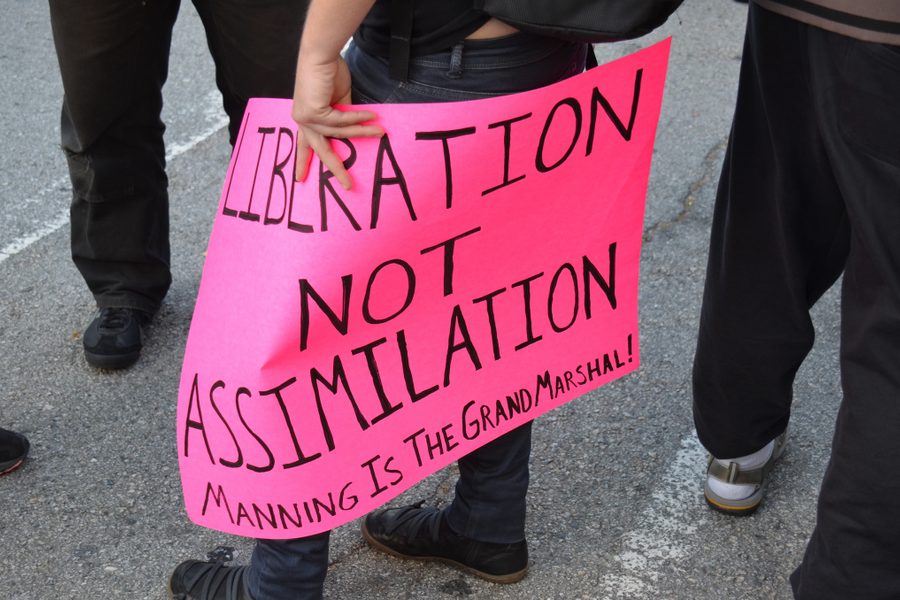Transgender People Are Not a ‘Burden’: The Massive Military Budget Is
Instead of looking to the U.S. military to preserve our rights, we should be dismantling it.
Tamara Nassar and Jake Valente

President Donald Trump recently announced an unofficial ban on transgender people serving in the U.S. military, describing their service as a financial “burden,” plagued with “tremendous medical costs and disruption.” Trump’s announcement was followed by a debate within queer communities about what this ban means for the transgender movement as it intersects with an anti-imperialist agenda.
Despite dissenting voices, the current discourse on the Left seems to be dominated by cheerleading for the marginal victory of transgender inclusion in the military, sidelining the queer community’s historic resistance to dependence on exploitative institutions, exemplified through the Against Equality organization and The Sylviaa Rivera Project.
Let us make one thing clear: The Department of Defense (DOD) should not be celebrated as an economic provider for the marginalized. Instead, we should reimagine a more socio-economically just distribution of resources that does not depend on an institution that enforces war and occupation.
Toxic and traumatic military culture
Many join the military not out of sheer patriotism, but to reap the benefits granted by an exploitative employer. Yet, following military service, many are left destitute, with veterans grossly overrepresented in the national homeless population. Veterans often return from service suffering from devastating Post-Traumatic Stress Disorder, contributing to a suicide rate of 20 veterans each day. Is the high likelihood of physical and psychic suffering worth the support of a system that, historically, has turned a blind eye on its most vulnerable?
Dean Spade, transgender activist and associate professor of law at Seattle University, spoke with In These Times about the trauma trans individuals experience in the military. “If we know that the U.S. military is this site of extreme sexual violence … then we could guess what it would be like for people to be trans in the military,” he said. “Because whenever there is intense sexual violence, trans people tend to be targeted.”
Spade added that the unaddressed culture of racism in the military is especially detrimental for transgender people of color. “The people that got kicked out the most of Don’t Ask Don’t Tell were black women, and often it would be because they would experience a lot of sexual harassment and sexual violence. And when they would report or refuse, they would be let go.”
The real burden
The U.S. government allocates approximately 48 percent of its federal budget on current or past military expenditures, according to the War Resisters League’s analysis of the 2017 proposed budget that accounts for announcements of new expenditures. Within the defense budget, the DOD spends more than three times as much on its private defense contractors than it does on veteran services and pensions.
Needless to say, allowing transgender personnel to serve openly would cause an insignificant increase in military healthcare expenditures, amounting to much less than a few of Trump’s Mar-a-Lago trips. It is crystal clear that the real economic burden is the defense budget.
We must refocus our movement toward a future where affordable healthcare and education exist outside of military binding, as many join specifically for those benefits. The Trump administration’s ad-hoc, scapegoating practices, deliberately targeting a vulnerable population, should not distract from the increasing intersectional awareness motivating many social justice movements today. Military tactics employed by TigerSwan to carry out operations on the Standing Rock Sioux Tribe and protestors of DAPL reveal further the parallels between U.S. imperialism abroad and at home.
Inclusion is not always liberation
According to Spade, the U.S. military and police departments showcase queer service members and officers as a form of pinkwashing, a term that describes marketing in which governments, corporations or institutions cultivate a queer-friendly image to divert attention from violence and human rights abuses they perpetrate. “Gay and lesbian politics [sometimes] colludes with the worst institutions in the United States and actually really rehabilitate them from left critique, and when [these institutions are] in crisis, they can slap a rainbow flag on their police car or say that the military is now on the side of gay and lesbian liberation or trans liberation, and get their PR to make that institution appear really progressive,” said Spade.
It comes as no surprise that the movement for queer liberation has a long history in its fight against the military, precisely because liberation is an encompassing concept. Spade spoke to us about how the anti-police, anti-war in Vietnam, anti-racism, and queer liberation movements were all emerging and prospering around the same time, and so influence was fluid between all these movements. It was a time when solidarity meant intersectionality. “There needs to be meaningful debates within queer and trans communities about what our politics are committed to,” says Spade.
The U.S. military is, and always has been, designed to dispose of those who the elite deem disposable. The violence that it espouses is the same violence the queer community has been historically fighting against. We must resist and reject the idea that the military is a body that can be mended with queer inclusion.




